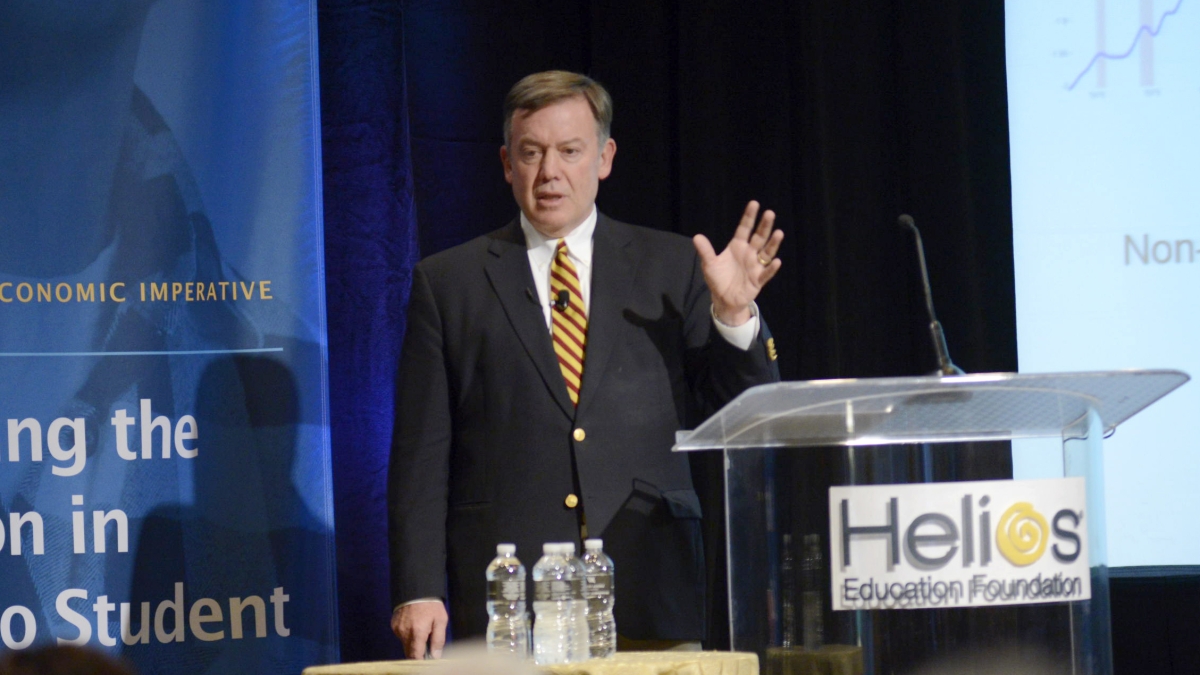ASU president: Major progress needed to bolster Latino success in higher education

Education is key for the success of Latinos and, in turn, for the success of the state itself. Yet only a small percent of Arizona’s Hispanic population will graduate from college, said ASU President Michael M. Crow.
Despite new programs and scholarships geared to bolster Hispanics in postsecondary education success, he said, that gap will only widen without game-changing progress.
"As a New American University, ASU is redefining higher education to increase access to a quality education, an effort that extends across all of America's income levels and communities," Crow said April 30 at an event hosted by the Helios Education Foundation at the Arizona Biltmore in Phoenix.
"We are also committed in our charter to taking responsibility for the broader community, for the community where we live and work. Both of these aims require that we address the Latino student-achievement gap. Arizona cannot fulfill its greatest potential if it fails to educate the fastest-growing populace in the state."
Crow said Arizona has an opportunity to lead the nation in closing the Latino student-achievement gap and securing a future where every student, regardless of income level, is prepared to succeed. However, poverty remains the biggest roadblock.
He noted that 58 percent of Latinos in Arizona live in poverty, a key determinant for college readiness and attainment. Without change or long-term solutions, it is projected that 62 percent of Latinos in the state will live in poverty, compared with 31 percent of Whites. That outcome could stagnate Arizona’s economy, burden government services and create more poverty.
Over the past decade, the university and Helios have developed several programs to encourage the success of Hispanic students, educators and administrators.
Those partnerships include the American Dream Academy, where parents and teachers collaborate to transform each child’s educational environment at home and school; the Hispanic Mother Daughter Program, sponsored by ASU's Cesar Chavez Leadership Institute; Spirit of Service Scholars, which honors outstanding students interested in pursuing careers in the public and non-profit sector; and Leaders for Learning, a principal-training program for Hispanic teachers.
But despite the university's attempts to create innovate pathways for Latino students looking to enter college, Crow said more is needed to address the shortfall and steer Arizona towards greater economic prosperity.
Helios Education Foundation CEO and President Paul J. Luna said that despite the gloomy statistics, he believes Arizona still has an opportunity to lead the nation in recognizing Latino success. But it must start at home and continue seamlessly through college.
"The solution starts with the agreement of what we're trying to achieve and understanding the importance of Latino future success," Luna said. "It's also about ensuring that parents and families start to build a college-going culture and that we provide resources and strong support mechanisms to Latinos, who traditionally come from underserved communities."
Crow’s presentation, “Arizona’s Economic Imperative: Leading the Nation in Latino Student Success,” was delivered before approximately 200 education, business, community and civic leaders looking to improve Latino college success as well as the state's future economic growth.
According to Georgetown University's Center on Education and the Workforce, by 2020, 65 percent of all jobs in the economy will require postsecondary education and training beyond high school. However, only 35 percent of Latino adults in Arizona have any post-high-school training and a mere 9 percent of Latino adults have a bachelor's degree or higher.
Since 2006, Helios has invested more than $155 million in educated-related programs and initiatives in Arizona and Florida.